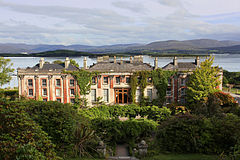Bantry House
| Bantry House | |
|---|---|

Bantry House and Bantry Bay
|
|
|
Location within Ireland
|
|
| General information | |
| Town or city | Bantry |
| Country | Ireland |
| Coordinates | 51°40′45″N 9°27′28″W / 51.67917°N 9.45778°W |
Bantry House is a historic house with gardens in Bantry, County Cork, Ireland.
Bantry House (originally called 'Blackrock') was constructed in about 1700 on the South side of Bantry Bay. In 1750, Councillor Richard White bought Blackrock from Samuel Hutchinson and changed the name to Seafield. The Whites had settled on Whiddy Island across the Bay in the late 17th century, after having originally been merchants in Limerick. The family prospered and considerable purchases of land were made in the area surrounding the house. By the 1780s, Bantry House comprised some 80,000 acres (320 km²) (though much of this would not be arable). The house has been open to tourism since 1946. Since about 1990 it has offered bed and breakfast accommodation.
The gardens to Bantry House were developed by the second Earl of Bantry and his wife Mary. Inspiration was taken from their travels across Europe. The gardens contain seven terraces; the house is located on the third. One hundred steps are located behind the house and are built to appear to rise out of a fountain and are surrounded by azaleas and rhododendron. The gardens are constantly tended and maintained.
By 1997 the grounds of Bantry House were suffering from neglect in certain places. A European grant was obtained to start the restoration process. Funding ceased in 2000. The restoration work is still ongoing.
During the aborted invasion of 1796, part of the Irish Rebellion of 1798, Bantry House was used for the storage of munitions by the defenders.
In 1796, Theobald Wolfe Tone and the United Irishmen attempted to land a formidable French armada, commanded by Admiral Hoche, in Bantry Bay. It was intended to expel the British and establish an Irish Republic. The armada consisted of 50 naval warships and 15,000 men. Richard White, having heard about the invasion had trained a militia to oppose the landing as he and his tenants were loyal to the British crown. Munitions were stored in Bantry House for safe keeping. Look outs were posted on Both Mizen Head and Sheep's Head to send warning of an invasion. In the end the French armada never had a chance of landing. The weather was too severe, and even ship to ship communication was too difficult. 10 ships were lost. One of these the 'Surveillante' remained on the bottom of Bantry Bay for almost 200 years.
...
Wikipedia

